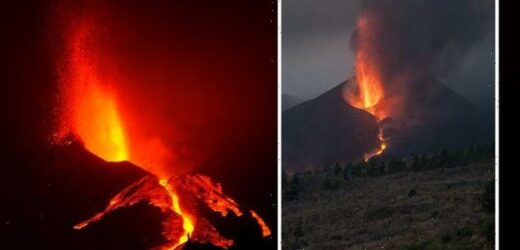La Palma: Volcano erupts and lava flows on Spanish island
We use your sign-up to provide content in ways you’ve consented to and to improve our understanding of you. This may include adverts from us and 3rd parties based on our understanding. You can unsubscribe at any time. More info
More than 50 earthquakes, including a magnitude 4.5 tremor, rocked the island in the last 24 hours, geologists have reported. Volcanic activity is not expected to see any time soon and may still pick up in the coming days. La Palma is now headed into the 26th day of the Cumbre Vieja eruption, which began on September 19.
The volcano has been steadily belching ash and smoke into the sky over the island.
It is estimated the volcano is presently releasing some 17,000 tonnes of sulphur dioxide.
Before scientists consider the eruption to be waning, they would expect to only see about 1,000 tonnes of the toxic gas escaping the volcano.
The National Geographic Institute (IGN) has also detected a total of 55 earthquakes in the volcano’s vicinity, indicating activity deep below the surface.


The eruption was preceded by a significant swarm of tremors on September 11.
Intense earthquakes are not a guaranteed warning sign of imminent eruptions, but cannot be discounted either.
According to the US Geological Survey (USGS), there are many volcanic processes that can trigger a wide range of seismic activity.
The USGS said: “Most volcano-related earthquakes are too small to feel, generally quite shallow (usually within 10km of the surface), and can occur in swarms consisting of dozens to hundreds of events.
“Most swarms usually don’t lead to eruptions, but most eruptions are preceded by swarms.”
La Palma: Smoke engulfs buildings near the Cumbre Vieja volcano
Scientists, therefore, pay close attention to the seismic activity around active volcanoes.
The movement of magma deep underground is one of the mechanisms that can trigger seismic activity.
Alternatively, scientists have proposed the seismicity is caused by the ground readjusting around Cumbre Vieja’s emptied magma chamber.
But with no imminent evidence of an explosive eruption, Cumbre Vieja’s lava flows remain the biggest threat to the island.


Since the eruption began, the volcano has covered some 680 hectares of land with molten rock, according to observations by the European Union’s Copernicus Sentinel satellite.
The flows have destroyed more than 1,500 buildings and forced thousands of people to flee for safety.
A video shared by the Volcanology Institute of the Canary Islands (Involcan) on Thursday shows red-hot lava gushing out of the volcano’s main cone.
Another video shows partly solid magma creeping up a road in the La Laguna neighbourhood.
There are presently three lava flows, which have forced local emergency services to evacuate a neighbourhood in the municipality of Los Llanos de Aridane.
A lava flow on the volcano’s northern flank also forced the evacuation of about 800 people from the La Laguna neighbourhood on Tuesday.
The Cumbre Vieja eruption is La Palma’s first volcanic eruption since Teneguia volcano erupted in 1971.
Thankfully, there have been no reports of deaths so far.
Additional reporting by Maria Ortega.
Source: Read Full Article

